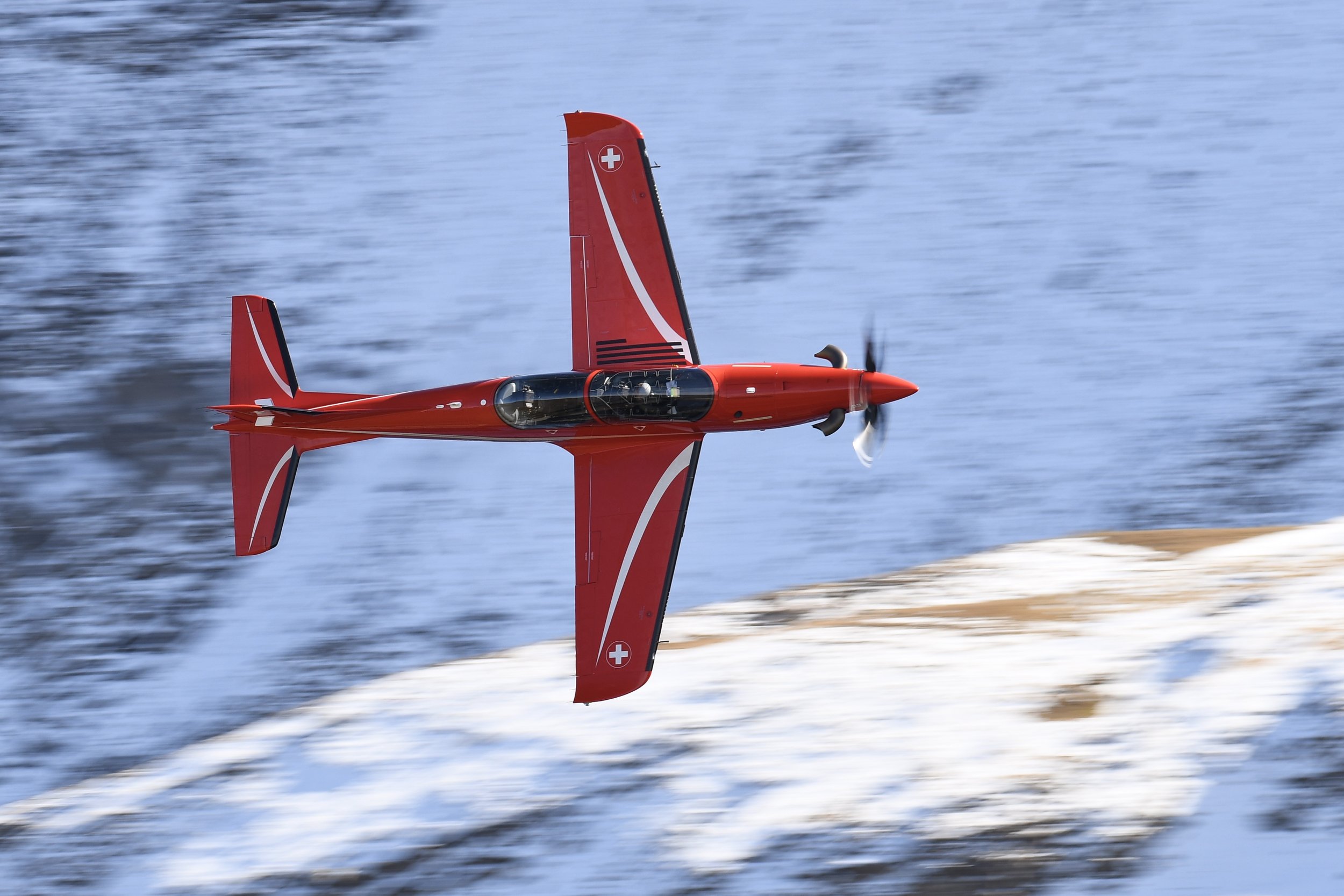
July 1 / Pilatus PC-21 first flight
First Flight 1 July 2002
Pilatus PC-21
The Pilatus PC-21 is a state-of-the-art turboprop advanced trainer aircraft developed by Pilatus Aircraft, a Swiss company with a long-standing reputation for producing high-quality training aircraft. The history of the PC-21 is a narrative of innovation, adaptation, and the quest to meet the evolving needs of military pilot training.
In the early 2000s, Pilatus Aircraft identified a gap in the market for an advanced trainer that could effectively bridge the transition from basic training aircraft to frontline operational jets. The existing trainers, such as the PC-7 and PC-9, were highly successful but did not fully address the increasing complexity of modern aerial combat and the advanced avionics found in contemporary fighter jets. Thus, the concept for the PC-21 was conceived, aiming to offer jet-like handling characteristics, advanced avionics, and high performance, all while maintaining the cost benefits associated with a turboprop engine.
The development of the PC-21 officially commenced in 2002. Pilatus set ambitious goals for the aircraft, intending it to be a comprehensive training platform capable of preparing pilots for the full spectrum of military aviation tasks. On July 1, 2005, the first prototype of the PC-21 took to the skies, marking a significant milestone in the project. The maiden flight demonstrated the aircraft’s innovative design and performance capabilities, powered by a Pratt & Whitney PT6A-68B engine. The PC-21 featured a digital glass cockpit with modern avionics, including three large multi-function displays (MFDs) and a head-up display (HUD), providing trainee pilots with an experience similar to operating modern fighter jets. Its wing design and airframe allowed for high agility and maneuverability, essential for advanced training scenarios. Additionally, the PC-21 integrated advanced simulation systems, enabling virtual tactical training and reducing the need for more expensive live training exercises.
Following successful flight tests and evaluations, the PC-21 began attracting interest from various air forces around the world. Between 2006 and 2007, the Swiss Air Force became one of the first to place an order, signaling confidence in the aircraft’s capabilities. In 2008, the Republic of Singapore Air Force (RSAF) became one of the first international customers, ordering the PC-21 to replace its aging fleet of trainers. This marked the beginning of the PC-21’s global adoption.
Throughout the 2010s, the PC-21 continued to gain traction internationally. Several air forces, including those of the United Arab Emirates, Qatar, and Saudi Arabia, selected the PC-21 for their pilot training programs. The aircraft’s success was driven by its ability to provide comprehensive training across a wide range of mission profiles, from basic flight training to advanced tactical exercises. In 2017, the Australian Defence Force selected the PC-21 as part of its AIR 5428 Pilot Training System, further solidifying the aircraft’s reputation as a leading advanced trainer. The contract included a significant number of aircraft, ground-based training systems, and support services.
In the 2020s, the PC-21 continues to be adopted by various air forces worldwide. Its versatility, cost-effectiveness, and advanced training capabilities make it a preferred choice for modern pilot training programs. The aircraft has proven to be a reliable and effective platform, preparing pilots for the demands of contemporary air combat environments.
The Pilatus PC-21 represents a significant advancement in military pilot training. Its development and operational history reflect Pilatus Aircraft’s commitment to innovation and excellence. By providing a high-performance, cost-effective training solution, the PC-21 has become an integral part of many air forces’ training programs, ensuring that pilots are well-prepared for the complexities of modern aerial warfare.
PC-21 Facts
Virtual Training Integration: The PC-21 is equipped with an embedded simulation system that allows pilots to conduct virtual tactical training missions while in the air. This capability significantly reduces the need for live training exercises, saving costs and enhancing training efficiency.
High G-Tolerance: The PC-21 is designed to withstand high G-forces, up to +8 and -4 Gs, which is comparable to many jet trainers. This allows trainee pilots to experience and adapt to the physical stresses they will encounter in frontline fighter aircraft.
Digital Maintenance System: The PC-21 features an advanced digital maintenance system that continuously monitors the aircraft’s health. This system helps to predict and manage maintenance needs, reducing downtime and improving overall fleet availability.
Aerodynamic Efficiency: The aircraft’s wing design incorporates winglets and other aerodynamic enhancements that reduce drag and improve fuel efficiency. This design not only enhances performance but also extends the aircraft’s operational range.
Noise Reduction: Despite its powerful engine, the PC-21 is designed with noise reduction features, making it one of the quieter aircraft in its class. This is particularly beneficial for training environments located near populated areas.
Ejection Seat: The PC-21 is equipped with Martin-Baker Mk16 ejection seats, which are among the most advanced in the world. These seats provide a high level of safety for the crew, capable of safe ejection at zero altitude and zero speed.
Advanced Avionics Suite: The avionics suite of the PC-21 includes a mission management system that integrates navigation, communication, and tactical functions. This system is designed to mimic the avionics found in modern combat aircraft, providing a seamless transition for pilots.
Multi-Role Capability: While primarily designed as a trainer, the PC-21 can be equipped for light attack roles. It has hardpoints on the wings that can carry a variety of weapons and sensors, making it versatile for different mission profiles.
Customizable Training Profiles: The PC-21’s onboard systems allow for customizable training profiles. Instructors can tailor the training scenarios to match the specific needs and skill levels of individual trainees, enhancing the effectiveness of the training program.
Global Presence: The PC-21 has a significant global presence, with operators in Europe, Asia, the Middle East, and Australia. Its widespread adoption is a testament to its versatility and effectiveness as a training platform, making it a cornerstone of modern military pilot training programs worldwide.











